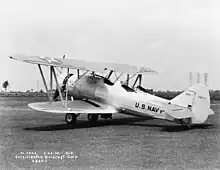| XB2Y | |
|---|---|
 | |
| Role | Dive bomber |
| National origin | United States of America |
| Manufacturer | Consolidated Aircraft |
| First flight | 1933 |
| Primary user | United States Navy |
| Number built | 1 |
The Consolidated XB2Y was an American prototype single-engined dive bomber of the 1930s. It was intended to meet a United States Navy requirement for a carrier-based dive bomber, but was unsuccessful, only a single example being built.
Design and development
In 1932, the United States Navy issued a specification for a two-seat carrier-based dive bomber capable of carrying a 1,000 lb (450 kg) bomb.[1] Orders were placed for competing prototypes of designs to meet the Navy's requirement with Consolidated Aircraft and the Great Lakes Aircraft Company in June 1932.[2][3]
Consolidated's proposal was the Model 24 (or XB2Y in the US Navy's designation system), a single-bay biplane developed from a basic design prepared by the Navy's Bureau of Aeronautics with detailed design led by Consolidated's B Douglas Thomas,[2] formerly Chief Designer of Thomas Morse Aircraft, which had become part of Consolidated Aircraft in 1929.[4]

In order to withstand the high g-forces experienced during pullup after a dive attack, much of the aircraft's center-section was cut from a solid steel block.[2][5] It was powered by a similar Pratt & Whitney R-1535 Twin Wasp Junior air-cooled radial engine as used by the Great Lakes design,[2][3] and had a fixed tailwheel undercarriage. The crew of two sat in tandem in separate cockpits, with the observer in the rear cockpit armed with a single flexibly mounted machine gun, and the pilot with a single fixed synchronized machine gun firing through the aircraft's propeller arc. Its bombload was carried on a crutch under the fuselage that swung down to ensure the bomb would clear the propeller when dropped in a steep dive.[2]
Operational history

The prototype XB2Y-1 (serial number 9221[6]) was completed in 1933, being delivered on 28 June 1933.[2] Testing was unsuccessful,[2] with the aircraft's performance being unsatisfactory,[7] while the aircraft also proved very expensive to build.[2][5] The US Navy preferred the Great Lakes design, with 60 being ordered as BG-1s.[3]
The XB2Y-1 was modified to a scout configuration, removing the bomb crutch. This allowed it to reach a height of 23,400 ft (7,100 m),[2] and it was used by NACA at Langley, Virginia for pilot view tests.[8]
Specifications (XB2Y-1)
Data from General Dynamics Aircraft and their Predecessors[9]
General characteristics
- Crew: two
- Length: 27 ft 11 in (8.51 m)
- Wingspan: 36 ft 6 in (11.13 m)
- Height: 10 ft 10 in (3.30 m)
- Wing area: 362 sq ft (33.6 m2)
- Empty weight: 3,538 lb (1,605 kg)
- Gross weight: 6,255 lb (2,837 kg)
- Powerplant: 1 × Pratt & Whitney XR-1535-64 14-cylinder air-cooled radial engine, 700 hp (520 kW)
Performance
- Maximum speed: 158 kn (182 mph, 293 km/h) at 8,900 ft (2,700 m)
- Range: 423 nmi (487 mi, 784 km)
- Service ceiling: 22,800 ft (6,900 m)
- Time to altitude: 10 minutes to 12,200 ft (3,700 m)
Armament
- Guns: 1 × fixed, forward-firing .30 in (7.62 mm) machine gun; 1 × flexible .30 in machine gun
- Bombs: 1 × 1,000 lb (450 kg)
See also
Aircraft of comparable role, configuration, and era
Related lists
References
Citations
- ↑ Donald 1997, p. 467.
- 1 2 3 4 5 6 7 8 9 Wegg 1990, p. 67.
- ↑ Wegg 1990, p. 14.
- 1 2 O'Bannon, Mark. "Model 24 XB2Y-1" Archived 2005-09-21 at the Wayback Machine. Consolidated Aircraft History. Retrieved 30 January 2011.
- ↑ Grossnick, Roy A. United States Naval Aviation 1910–1995. Washington DC: Naval Historical Center, 1997. ISBN 0-945274-34-3. "Appendix 9: Bureau (Serial) Numbers of Naval Aircraft" Archived 2001-08-07 at the Wayback Machine, p. 530.
- ↑ Flight 14 February 1935, p. 179.
- ↑ "Nasa Images:Consolidated XB2Y-1" Archived 2011-07-27 at the Wayback Machine. NASA. Retrieved 30 January 2011.
- ↑ Wegg 1990, pp. 67–68.
Bibliography
- Donald, David (editor). The Encyclopedia of World Aircraft. Leicester, UK:Blitz Editions, 1997. ISBN 1-85605-375-X.
- Swanborough, Gordon and Bowers, Peter M. United States Navy Aircraft since 1911. London:Putnam, Second edition 1976. ISBN 0-370-10054-9.
- "United States Navy Aircraft". Flight, 14 February 1935. pp. 178–179.
- Wegg, John. General Dynamics Aircraft and their Predecessors. London:Putnam, 1990. ISBN 0-85177-833-X.
External links
![]() Media related to Consolidated XB2Y at Wikimedia Commons
Media related to Consolidated XB2Y at Wikimedia Commons